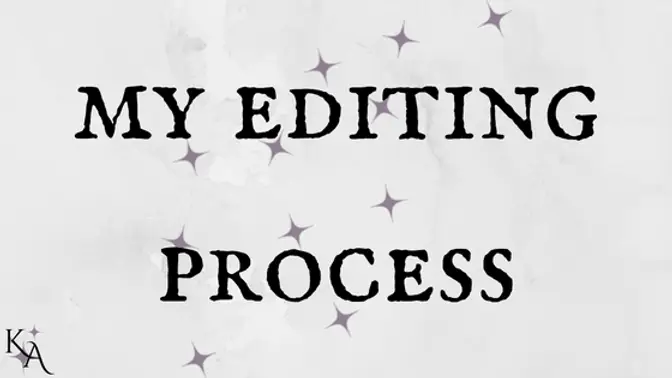Hey, it’s Kay. I recently finished editing my debut (coming next year), and it revealed quite a lot about my writing process, so I thought I’d share how I edit and what I learned.
My drafting process is pretty simple—write it wrong, then write it right. My zero drafts are almost always completely rewritten, with the bare bones remaining as a foundation to build upon. Some paragraphs are kept, but it’s almost always an entirely different book between drafts, and it’s so weird still having those other scenes in my mind and knowing they don’t exist anymore in the real thing. I wrote two books during the pandemic (my debut and my Peter Pan retelling), and both involved the characters wearing masks or making comments on airborne illnesses. Well, not anymore. That scene didn’t make it from draft zero of my debut. But it still exists in my mind, so clearly, because I was writing during a time when that was all I knew.
But we’re not here to talk about drafting, and the Frankenstein-esque way scenes continue to live on even after they’ve been scrapped. I want to talk about my editing process, and how it revealed a lot about the way I use sentence structures and words like they’re personal comforts to me.
When my editor/publisher Zara came back with Book 1 edits, I was surprised there wasn’t much to change in a macro way. Just a few things to add or take away, but nothing of the plot changed. Nothing about the characters or their motivations changed. There were some glaring plot holes (how would this one character know another’s name when they’ve never met, or why doesn’t this character recognize this other one when they’ve been chasing them for so long), but those were easy to fix. Just a few lines added in here and there, just a few lines taken out here and there. I know developmental edits are a big thing in traditional publishing, and I’m glad Zara was so easy to work with regarding any changes. In that there were so few. I didn’t need to rewrite my entire book again. It finally made sense.
Then I got into line edits. I chose to do them before sending the big change edits back to Zara, because I had a month before my due date and wanted to experience it. That’s where I learned how often I lean on certain sentence structures or certain words. I knew this earlier about my repeating sentence structures, but I was surprised to see how often I used “as” when referring to a character doing things at the same time. “I looked at her as she looked at me.” “I cleaned my knife as blood dripped from the body at my feet.” As, as, as. As though my characters always had to be doing things simultaneously. That was incredibly boring to read. I pride myself on my prose (lyrical, but not flowery), so it was a shock to see just how wrong I was.
But I loved it. I loved twisting each sentence into something different, something better. Something that wasn’t as repetitive, but just as lovely to read. Something sibilant. Something savoury (note from Zara: Kay is Canadian, so this is not a typo). My favourite author is VE Schwab for this very reason. Her prose sings across the page. I want readers to taste each word and enjoy them, not get hung up on how often it appears in one paragraph. I had to rewrite one sentence where 25% of it was the word “you.”
In the writing world, there are certain phrases or words called “crutch” words. The ones we lean on more often than others. I noticed in most of Adrienne Young’s earlier works, it’s “pulled.” Yes, the thesaurus is a great tool, but it can also be a hindrance, and there’s a fine line between using one word repetitively when it’s the best word to convey your meaning and using a vastly different synonym that doesn’t mean what you think it means. Inconceivable, right? (Sorry, I just laughed at myself for that reference, don’t mind me).
Aside from “as,” I’m not sure I have one. Going through line edits, I didn’t see any particular word that stuck out to me more than others, because I have a very poetic way of describing things and a very specific way of using punctuation. I use parallelism and repetition a lot. Groups of words or phrases used in slightly different ways. If I’m writing a list, each point should have three words, or I make sure each new point has one more word than the last. That’s where my brain goes to when I’m drafting. That’s where I get hung up on, and I can’t move on until it looks right. Sounds right. Is right. Line edits are meant to challenge the way you look at your own writing, right? My document is very colourful because of all the nitty-gritty bits I broke and put back together again, but not quite right. Not wrong, either. Just different. Better, I think.
I really enjoyed line edits. Combing through my book, seeing how the details unfolded through individual words. I think it made me a better writer. I hope it made me a better writer. It’s been almost three years since I finished writing my debut. And, in that time, I wrote two more books. Looking back, a lot has changed. Hopefully, my writing has only gotten better. I’m drafting the sequel now, and I’m putting what I learned into practice. I can only hope my efforts are noticeable when you pick up Book 1, and enjoy it as much as I enjoyed editing it. I almost forgot what I was like to live in the world I created three years ago, but it’s like a breath of ocean air. It’s like coming home.
Until next time, happy writing!

